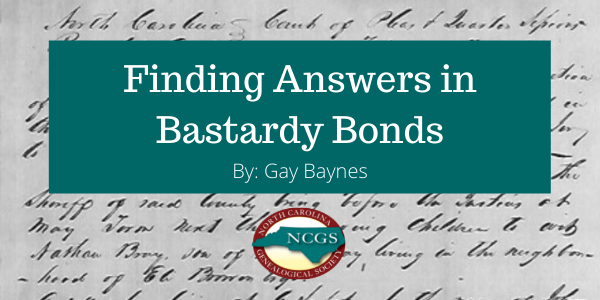By: Gay Baynes
We’re excited to share a guest post by NCGS Executive Committee Member, Gay Baynes. She shares her experience of researching a great-grandmother and uncovering answers to her research question through bastardy bonds. You’ll find additional resources and links at the bottom of the article.
I was an absolute beginner and researching my “quirky” great-grandmother Elizabeth. She appeared to be part of a complicated family with several sets of children. She had three daughters (23, 14, 8) and two sons (8, 5). She also seemed to have carefully dodged any need for marriage records.
Defeated in my search for fathers and floundering in the North Carolina State Library, one of the knowledgeable and kind librarians suggested I check County Bastardy Bonds. I was a bit surprised by her suggestion. I did say I was a beginner. I had never heard of bastardy bonds. My slightly shocked response was rewarded with a thorough description of the legal procedures of these bonds.
The librarian quietly explained that throughout legal history, bastardy bonds imposed sanctions on the parents of those born out of wedlock. The laws were created to encourage conventional morality and to protect property from “hidden heirs.” The laws also protected the county’s budget. If the court could pressure the mother into identifying the father, then the father was responsible for the financial upkeep of the child through the posting of a bond. Naturally, the county was no longer burdened. If the mother refused to tell, she could be forced to post bond for the financial upkeep of her child, a possible jail sentence, or the child might be bound out as an apprentice if he was of a certain age.
Bracing myself for unknown territory, I jumped on the elevator and landed in the North Carolina State Archives. There was no doubt that the location of my renegade ancestors was Randolph County. I had a range of birth dates from about 1825 to 1860. After learning how to request records, I received a box of folders stuffed with dusty loose papers. Honestly, I did not know what I hoped to find in this mysterious stack of court documents. After the first dozen, I got the hang of it and began to know where to look for the vital information. As I continued to read, I kept thinking that Elizabeth might be a widow with children from a first marriage. She might have been abandoned by the father of the younger group and found that she needed help from the courts. I have a lot of imagination. And then I reminded myself that these bonds have to do with illegitimate children. I discreetly and quietly continued my quest.
As I neared the bottom of around a hundred bonds, there was the youngest boy’s name. I didn’t know whether to jump for joy or cry out in despair.
Wait, what? Nathan … son of Wincey! His mother was not Elizabeth! What? It was one of Elizabeth’s daughters! Now I really had no idea which of the other children were Elizabeth’s and which were Wincey’s.
Oh no, more missing fathers.
This bastardy bond was shocking, extraordinary, and rewarding. It dramatically changed my family landscape. It added an entire generation to the tree, not to mention total confusion on mothers and fathers.
This single document led to a heap of questions.
What did the court do with Nathan? He was 6 at the time. Was he bound out as an apprentice? What happened to Wincey? Did she tell? Who was the father? I needed those court minutes to flesh out this discovery. And yes … now I had several “significant others” to locate.
More research, of course.
Back to the Archives desk to request more records.
Search North Carolina Bastardy Bonds for free at FamilySearch.org.
Learn more about Bastardy at NCpedia.
Watch Tracing Ancestors Born Out of Wedlock with Lisa Lisson.
Would you like to write a guest post for NCGS? We would love to hear from you. Contact content@ncgenealogy.org for more information.

